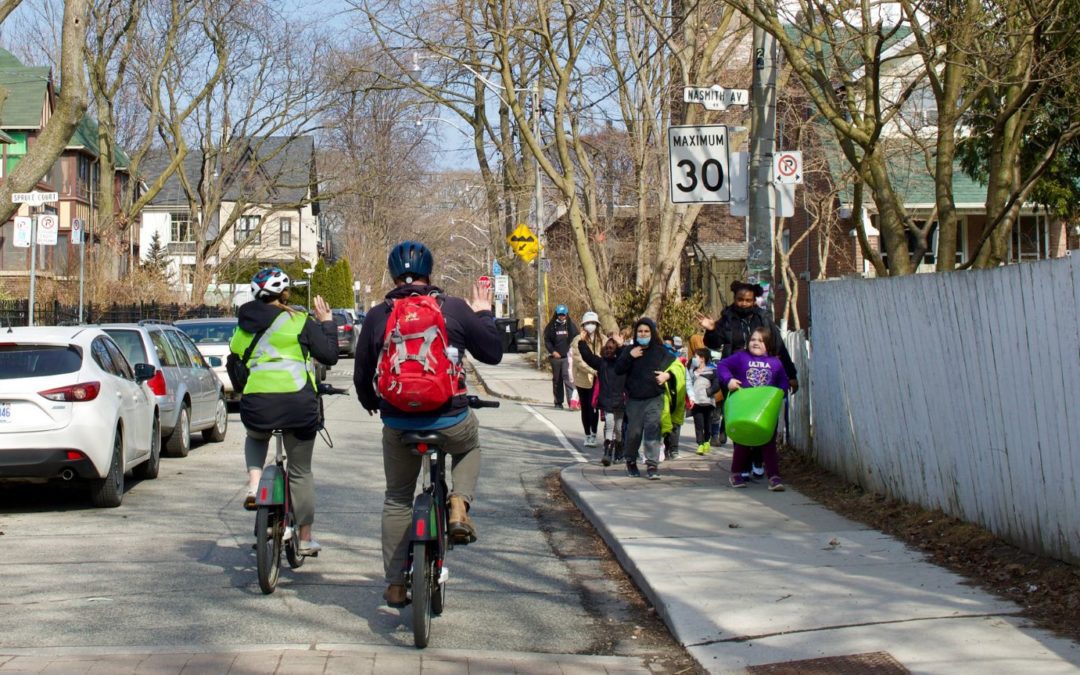Project Rationale
There is a clear data gap when it comes to understanding the way young people across Canada get around, especially to and from school. Without this data, it is difficult to understand and address the transportation challenges and barriers facing families. Most critically, the lack of data severely limits any evaluation efforts to monitor the effectiveness of active transportation strategies, plans, and built environment improvements over time.
Furthermore, measuring and monitoring travel behaviours enable equitable infrastructure investments where they are most needed, help develop collaborative initiatives to get more children and families traveling actively, and establish baseline data to evaluate progress towards federal, provincial, and municipal mode shift and greenhouse gas emission reduction targets.
The main project outputs will be to conduct statistically significant provincial school travel surveys, establish a baseline travel mode share for school journeys, and publish the survey and data findings to inform active transportation infrastructure prioritization. We believe this project will build critical momentum and capacity for a future longitudinal national data collection initiative that will strengthen Infrastructure Canada’s investments in active travel.
Fund Recipients
Infrastructure Canada has announced several active transportation investments in communities across the country, sharing a range of successful capital and planning projects. Some of the projects publicly announced thus far include:
- City of Greater Sudbury – Paris-Notre Dame Bikeway to see physically separated cycling paths on either side of the roadway and upgrades to sidewalks, curbs, crosswalks, signage, lighting, furnishings and landscaping. An additional investment to develop wayfinding guidelines also supports residents to navigate streets and trails by active modes.
- City of Mission – 7th Avenue Greenway to include a protected two-way bike lane, floating bus stops, and additional landscaping, helping improve access to parks, schools, and other important destinations.
- City of Chilliwack – The ‘Experience the Fraser Multi-Use Pathway’, will support the design, development, and installation of information kiosks along the Vedder Greenway, providing reference points for bike network users. The project is led by Tourism Chilliwack in collaboration with Indigenous partners to offer inclusive and historical perspectives on the land and waterways.
- Municipality of the District of Lunenburg – Developing a new Active Transportation Plan, replacing the previous version and expanding the information available to community members.
- Village of Greenwood – To develop a trail concept plan, examining the feasibility of connecting and expanding existing trails within the community, and connecting trails with the Village of Kingston.
- City of Miramichi – Implementation of priority projects identified in the city’s Active Transportation Plan, including pedestrian paths, multi-use paths, a dedicated crossing, shoulder widening, and the addition of a dedicated bike lane.
- City of Vancouver – Conduct a feasibility study of building a greenway running north-south through East Vancouver. The city will collect data at key intersections, assess traffic impacts, undertake stakeholder consultations, review best practices, and develop cost estimates.
- District of Chetwynd – Develop the Saulteau First Nations Trails Network Plan, an active travel strategy for Saulteau’s reserve. The strategy aims to identify key trail connections between destinations, including health facilities, school and daycare centres, businesses, culturally significant areas, and administrative buildings. The plan will include significant community engagement to ensure the final plan reflects the Nations’ priorities, and incorporates Saulteau’s history, language, and culture into the trail network.
More project announcements will come soon, with details available in the Media Centre and through Infrastructure Canada’s Twitter (EN and FR).
Reflections
Active transportation advocates who helped champion the government’s National AT Strategy and Fund identified a number of “hopes” for the funding, including:
- Indigenous and rural communities would receive funding
- Funding would be allocated to projects for protected facilities, improved trail connections, and intersection treatments
- There would be dedicated funding for a National Active School Travel program
- There would be increased collaboration between government departments and external partners, and
- Public and elected officials would demonstrate increased support for active and sustainable modes of travel
Based on the fund recipients announced thus far, we are pleased to see funding going towards Indigenous and rural communities, protected facilities, improved trail connections, and intersection treatments. There also appears to be greater collaboration between government departments and levels of government, with increased cross-jurisdictional collaborations and visible support for active transportation.
While a National Active School Travel program is not yet a reality, GCC and ASTC are encouraged to see investment in data collection for children’s mobility and other youth-oriented projects.
Background
The federal government announced the first-ever federal strategy and dedicated fund for active transportation in July 2021. The $400 million fund prioritizes investments in infrastructure, such as bike lanes, multi-use paths, and recreational trails for walking and wheeling. This announcement was widely celebrated by AT advocates who had been mobilizing for federal action for decades.
Infrastructure Canada opened the first round of applications for planning and capital funding streams in January 2022. The fund received significant amount of applications, demonstrating a pent-up demand for active and sustainable transportation projects across the country.
Stay tuned for project updates at @OntarioAST and @GrnCommunities on Twitter, @GreenCommunitiesCan on Facebook and Green Communities Canada on LinkedIn as we begin to roll out our walking and wheeling counts this spring.

Trackbacks/Pingbacks